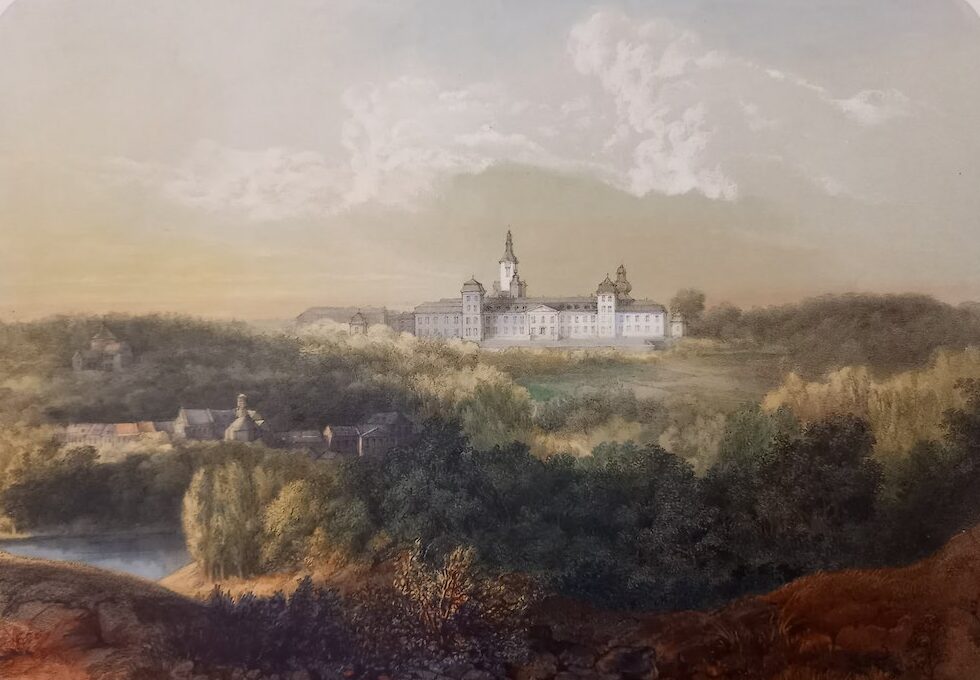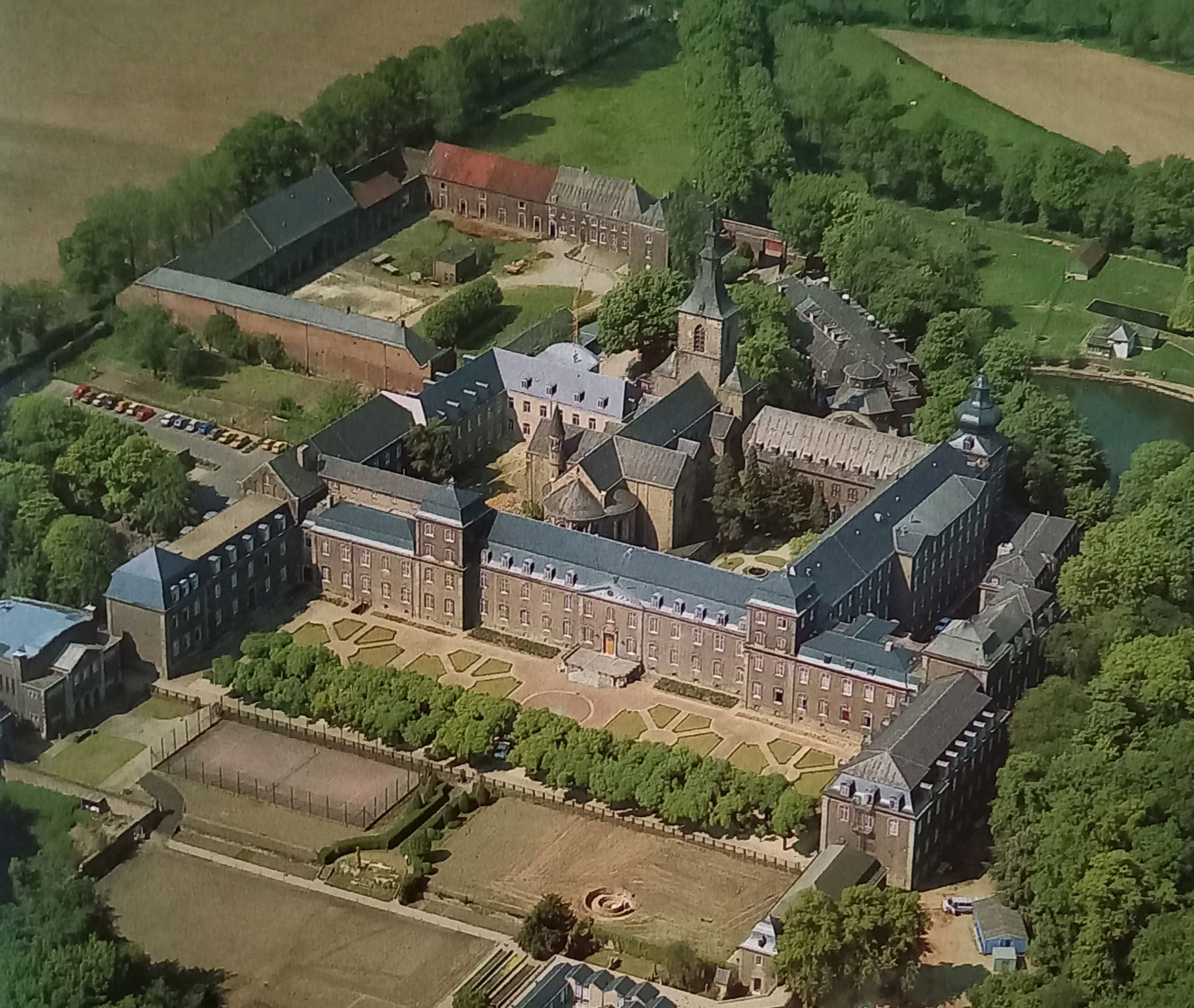Rolduc Abbey

Rolduc Abbey – East side, left Rode Castle and St. Mariä Himmelfahrt Church – Painting by Alexander Schaepkens, 1859 (Rolduc Archives)
A monument with a rich history
In the year 1104, the young priest Ailbertus van Antoing and his two brothers arrived at the Rode Estate. They led a pious and very modest lifestyle, in absolute poverty. Count Adelbert von Saffenberg, owner of Rode Castle (in present-day Herzogenrath), gave them a piece of land on which they built a simple shelter and a wooden chapel. Over the next 900 years, this grew into the largest monastery complex in the Benelux, and one of the Top 100 UNESCO monuments in the Netherlands: Rolduc Abbey.
The wealthy Embrico of Mayschoss joined Ailbertus with his family, and donated his entire fortune to the small community. In 1106, they started building the crypt and laid the foundations for the monastery church. Following a number of disagreements with Embrico, Ailbertus left the Rode Estate in 1111. He died in 1122 in Sechtem near Bonn. In 1895, the bones thought to belong to Ailbertus were brought to Rolduc and buried in the crypt that he and Embrico built.
The first abbot of the monastic community was Richer from Rottenbuch in Bavaria. The community became a monastery for Augustinian canons, who initially lived according to very strict rules. Their existence revolved around community life, the rejection of private property, choir prayers, strict fasting, and manual labour. The abbey was called ‘Klosterrode’, then ‘Klosterrade’ at a later date. In 1136, guardianship of the abbey fell into the hands of the dukes of Limburg, who considered Rolduc to be their family monastery. Various dukes are buried at the monastery, the most famous of whom is Walram III.
In the mid-12th century, the abbey experienced a golden period that continued until well into the 13th century. By 1250, the abbey owned more than 3,000 hectares of land, and the number of monks grew consistently. The library became one of the most important of its time. Several new monasteries were also founded from Klosterrade, including Marienthal in the Ahr Valley, Sinnich near Teuven, Hooidonk near Eindhoven, and Scharn near Maastricht.
In the 14th, 15th and 16th centuries, the abbey suffered a prolonged period of spiritual and material decline. The buildings suffered greatly from the Eighty Years’ War (also known as the Dutch War of Independence) and the Thirty Years’ War. It was not until around 1677 that the abbots Van der Steghe and Bock managed to reintroduce stricter monastic rules.
After the death of Abbot Heyendal, a power struggle arose between Abbot Rauschauw (1733-1745) and ‘Prick-Koehler’, one of the most influential charcoal burners in the Rode Estate. Abbot Rauschauw decided to terminate the contract with Prick-Koehler in 1741, because Prick-Koehler leased the right to mine coal owned by Rolduc, but this provided little benefit to Rolduc. This decision led to a general economic and social shift.
At an extraordinary chapter meeting in 1742, the abbey took the definitive decision to take over the operation of the mine itself, as the mine was in poor condition. The abbey even had to import coal from other countries. Rolduc did not have enough coal for its own use or to sell, but bought coal from the neighbouring German hinterland. This led to a succession of drawn-out lawsuits between the monastery, families, and charcoal companies.
The poor condition of the roads prompted Abbot Chaineux to improve them. In May 1783, Holy Roman Emperor Joseph II gave the abbey permission to build new roads at its own expense. This led to the 5-km long route from Holzstraat via Hoofdstraat, Kerkradersteenweg, Kaalheidersteenweg, and Heerlenersteenweg towards Heerlen-Maastricht. What made these new roads particularly unusual was that they were paved, which made it easier to transport heavy coal wagons to Heerlen and Aachen. The monastery also built a 7-km road from Pannesheide via Nieuwstraat to Geilenkirchen, which was mainly designed to transport coal to Aachen and the north. Coal mining continued in the mines managed by Klosterrade Abbey until 1795.
In 1794, the armies of the French Republic occupied Limburg. Many monasteries, including Rolduc Abbey, were secularized and confiscated. Abbot Chaineux and the canons fled across the Rhine with all their possessions, while the monastic property and the coal mines were nationalized. An inventory of the mining area belonging to the abbey was drawn up, and the debts and obligations identified. This turned out to be problematic, because the abbot had taken some of the money and archives with him.
The Rolduc Abbey mines, nationalized by the French, were concentrated around Strass and Maubach. They became state properties called ‘domains’, which led to the mine name Domaniale, for which the French had shaft Number II built. This signalled the end of an important phase for the Rode Estate and coal mining in the region. In the late 18th century, the abbey was given a new name: the French translation of Herzogenrath, ‘Rode-le-Duc’, was abbreviated to ‘Rolduc’.
Catharina Scholtens

Rolduc 1936 (Rolduc Archive)
Boarding school and seminar
The buildings then stood empty for 35 years. In 1831, the priestly training of the diocese of Liège was brought to Rolduc. After the separation of Belgium in 1830, this moved to St. Truiden. Rolduc became the property of the Bishop of Roermond. Rolduc became a boarding school with a grammar school and the fields of study theology and philosophy for boys from the upper classes. Various well-known politicians, scientists and writers of the time enjoyed their education in Rolduc. From 1946 to 1967 it was again exclusively a minor seminary for the Rolduc diocese. The boarding school was closed in 1970. The school for secondary education remained at Rolduc until mid-2011.
Cultural heritage
Rolduc is the largest imperial monument in the Netherlands. The Episcopal Centre sees it as its task to ensure the preservation of Rolduc’s cultural and spiritual heritage. In the 1970s, the abbey complex was thoroughly restored. Since then, Rolduc has been used for multifunctional purposes. Today, the more than 917-year-old complex houses a hotel with conference centre, a monastery brasserie, flats, offices and practice rooms as well as the seminary of the diocese of Roermond. In 1992, Rolduc received the Europa Nostra Award, a prize given to restorations that contribute to the preservation of the European cultural heritage.
Tours and events
Guided tours are organised for the public every Wednesday and Saturday afternoon and on Sunday mornings and on request. A visit to the historic monastery garden and the Ailbertus vineyard and brewery is also well worth the effort.
Bookings under: Rondleidingen – Bisschoppelijk Centrum Rolduc (bcrolduc.nl)
Catharina Scholten
